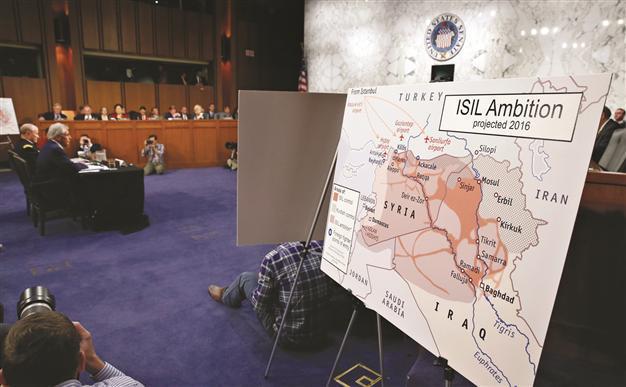A very disturbing map of ISIL for Turkey

REUTERS Photo
The map titled “ISIL Ambition, projected 2016” was shown during a testimony by U.S. Secretary of Defense Chuck Hagel and Chairman of Joint Chief of Staff General Martin Dempsey to the Senate Armed Services Committee on Sept. 16.
This was the meeting where Dempsey mentioned the use of ground troops in operations against the Islamic State of Iraq and the Levant (ISIL), both in Iraq and Syria, in the event that U.S. President Barack Obama’s “no-boots-on-ground” strategy in the fight against ISIL fails. The White House made it clear afterwards that Dempsey’s suggestion, even as a possibility, was out of the question; but still the word was spoken.
Most of the Turkish media covered the story from the possibility of the use of American troops in the fight. That could be partly because of the reaction of President Recep Tayyip Erdoğan and the government regarding media reports about potential militants with American and European passports using the Turkish border with Syria to join ISIL. There are Turks too, with official estimates suggesting more than 1,000 Turkish passport-holders have crossed the border to join ISIL
(HDN, Aug. 2, 2014). Actually, Turkey has been in close cooperation with its U.S., European and Arab partners to stop this flow for at least the last four months
(HDN, June 6, 2014).
In a public speech on Sept. 17, Erdoğan slammed such media reports about Turkish jihadists (including a recent one by the New York Times). “They are trying to show us as being related to terrorism. They are trying to give Turkey a bad name,” he said.
Erdoğan, addressing the issue so clearly for the first time, categorically denied that Turkey was involved in illegal oil trade with ISIL-linked smugglers, was providing arms to ISIL and was giving medical treatment to its militants.
However, as you can observe from the photos above, the map shown during Hagel and Dempsey's testimony showed the route of potential ISIL militants through Turkey to Syria.
The most used route is the one starting from the Istanbul’s international Atatürk Airport. Then, ISIL recruits find their way to the 910-km-long Syrian border either with local flights to the border cities of Hatay, Gaziantep and Şanlıurfa or by land routes. The map shows the crossing points as being the towns of Reyhanlı, Kilis and Akçakale, all of which have official border gates.
Now, the following are from the testimony map, but they are necessary to understand the bigger picture better: The Syrian side of the Cilvegözü border gate of Reyhanlı is under the control of the rebel Free Syrian Army and Islamic Front forces fighting against the forces of Bashar al-Assad, ISIL and al-Nusra. The Syrian side of the Öncüpınar gate near Kilis is under Islamic Front control and Çobanbey is under ISIL control. ISIL also controls the Syrian side of the Akçakale gate.
(Look at the map, HDN, Sept. 16, 2014)Both the U.S. and Turkey have far more detailed maps than the one exhibited in the U.S. Senate, but the fact that the map shows Turkey as the main passage to Syria for ISIL terrorists disturbs Ankara.
The fact that Turkey is not the only country to opt out of military action despite taking part in all other areas - like intelligence sharing, trying to stop foreign fighters, opening up bases for logistical and humanitarian support, and bearing the burden of 1.2 million Syrian refugees - makes Ankara more upset. Perhaps it recalls past mistakes regarding being too open to the demands of Syrian opposition groups. Britain and Germany, for example, took exactly the same stance as Turkey, despite being thousands of kilometers away from the theater and not having 49 of their citizens held hostage by ISIL for more than three months.
“Turkey could surely say more than it says and could do much more than it does,” Deputy Prime Minister Yalçın Akdoğan told a group of reporters on Sept. 17. “But even one of our citizen’s lives is very important to us. That’s why we are moving in a very cool-headed way in this process.”
But the map is there and Turkey will have to work hard to alter the perception of at least being tolerant of ISIL. The situation and what is to be done about it was the subject of an emergency security meeting chaired by Erdoğan and the security-related members of the government, the joint chiefs of staff, intelligence officers and diplomats. Perhaps the time for Ankara has come to take public and concrete steps about the crisis on its southern borders.
